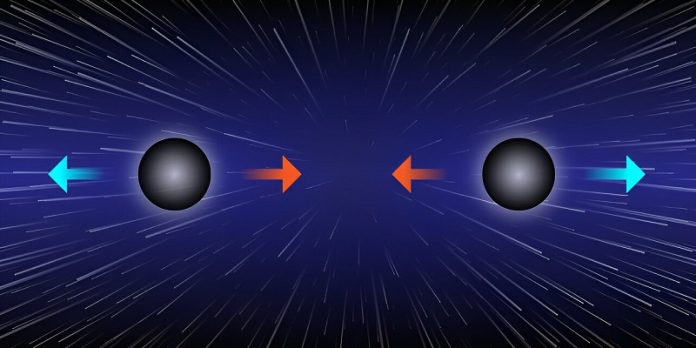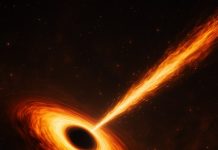
Black holes are like the vacuum cleaners of the universe.
Imagine a super-strong whirlpool that pulls everything into it, even light!
Now, scientists think there might be a pair of these space vacuums dancing together, looking like one from afar.
Researchers from different universities teamed up for this interesting discovery.
They include scientists from the University of Southampton, the University of Cambridge, and the University of Barcelona.
Their main question was: In a universe that keeps growing, could two black holes exist side by side without crashing into each other?
Now, let’s rewind a bit. A black hole is a mysterious spot in space where gravity is so strong that nothing can get out.
Think of it like a sinkhole that swallows everything nearby. And when we say everything, we mean everything – even light can’t escape its pull!
If you could squeeze all the stuff that makes up Earth and put it in a space the size of a pea, that’s how dense a black hole is.
Most of the time, when people think about black holes, they think of just one, all by itself. This is because the general idea has been that if you put two black holes near each other, they’d be drawn together by gravity and smash into each other.
However, this idea works if we think the universe is just sitting still.
But guess what? Our universe is like a balloon that’s being blown up, getting bigger and bigger all the time. This growing universe is powered by something called “dark energy.”
Professor Oscar Dias, one of the scientists, explained that this dark energy is a bit like a mystery power pushing the universe to expand. Because of this force, black holes might behave differently.
The team used some fancy math and found that two black holes could live next to each other without crashing. This is because while the universe tries to push them apart as it expands, their strong gravity pulls them towards each other.
It’s a bit like two friends holding hands while floating on water, trying not to drift apart. From far away, these two close black holes could look like just one.
Professor Dias said that if you were looking from a distance, you might not be able to tell if it’s one black hole or two buddies side by side.
Another scientist, Professor Jorge Santos, added that their idea works for black holes that are not spinning. But he believes that spinning black holes might also pair up.
And maybe, just maybe, there could be groups of three or even four black holes hanging out together. Imagine that – a whole group of space vacuums, chilling in space!
This research sounds like a cool sci-fi story, right? But it’s actually real science. The team, which includes Professor Dias, Professor Gary Gibbons, Professor Santos, and Dr. Benson Way, shared their findings in a respected science journal called Physical Review Letters.
So, the next time you gaze at the night sky, wonder about those mysterious black holes. Who knows, maybe some of them have a dancing partner we don’t know about yet!
Follow us on Twitter for more articles about this topic.
Source: University of Southampton.



